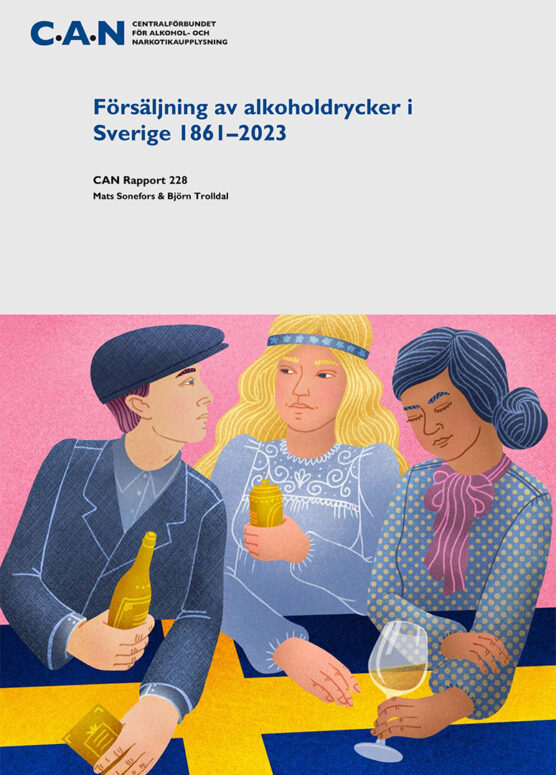Sweden’s drinking habits: 162 years of Bottoms Up and Crackdowns
AlcoholBjörn Trolldal, CAN Published 14 May 2025
This article depicts a study examining and analyzing historical sales data for alcohol, linking them with sales figures from later years. The result is an extensive time series spanning 162 years, offering unique insights into shifts in alcohol sales and consumption patterns over time. While the dataset captures the majority of alcohol sales, unregistered sources, such as home distillation, are naturally not accounted for in the same way. The study was conducted by Mats Sonefors and Björn Trolldal.
Total sales
There have been significant shifts in beverage preferences between 1861 and 2023. In the early years, spirits overwhelmingly dominated alcohol sales, but by the end of the period, wine had become the leading choice. During the first two decades, total alcohol sales averaged nearly 9 liters of pure alcohol per inhabitant aged 15 and older, peaking at 11.3 liters in 1874. Sales then fluctuated with economic conditions, declining during downturns and poor harvests but increasing in times of prosperity.
At the turn of the 20th century, various social and alcohol policy measures were introduced. For example, beer taxes were raised, and local monopolies for spirit sales expanded, leading to a decline in overall sales. The period of general restrictions during World War I had a clear impact on sales of alcohol.
From 1919 to 1955, a strict rationing system limited alcohol sales, keeping annual consumption at around 4 liters per person, with some variation. After World War II, sales increased, peaking after the abolition of rationing. At that point, prices were raised, and sales then declined somewhat.
In mid 1960s, the introduction of a beer with higher alcohol content in grocery stores drove total sales of alcohol to nearly 8 liters by 1976. When sales of this beer were discontinued in 1977, total sales dropped and remained at just over 6 liters for a period. In the early 2000s, sales increased again, stabilizing at just over 7 liters per person by the end of the study period.

Sales of alcoholic beverages in total and divided by beverage categories during the period 1861-2023, in liters of pure alcohol per person aged 15 and older. Öl = beer, vin = wine, Sprit = spirits.
Sales of Spirits
At the start of the period, spirits accounted for approximately 90% of total alcohol sales. Sales then declined until World War II, when they briefly increased again. Apart from a peak in the mid-1950s, spirits sales remained relatively stable until the 1970s, after which they declined further. By the end of the period, spirits accounted for around 15% of total alcohol sales, measured in pure alcohol.
In 1989, beer surpassed spirits as the most sold alcoholic beverage (measured in pure alcohol), a position beer held until 2002. Since then, wine has remained the most sold alcoholic beverage in Sweden.
Sales of Wine
In the early years, wine sales were minimal. However, from the mid-1950s onward, they began to rise steadily. This upward trend continued over the following decades, with wine consumption stabilizing in the 2010s. By the end of the study period, wine accounted for nearly 50% of total alcohol sales, measured in pure alcohol.
Sales of Beer
Beer sales increased during the beginning of the study period until 1900. After that, sales remained at a lower level until 1965, when the introduction of a beer with a higher alcohol content in grocery stores led to a sharp rise in beer sales. However, when the sales of that type of beer was discontinued in 1977, primarily for alcohol policy reasons, total beer sales declined. Sales of beer rebounded in the late 1980s and have remained relatively stable since then.
Conclusion
Both Sweden as a country and its alcohol culture have undergone major transformations over this period. Sweden began as a nation with a strong spirits culture but gradually transitioned into one where wine and beer are the dominant alcoholic beverages.
At the beginning of the period, Sweden was a relatively poor country, and men accounted for the vast majority of alcohol consumption. Industrialization was already underway, but by the end of the period, Sweden had become a post-industrial nation, fully integrated into Europe. Alcohol consumption has reflected these societal changes, becoming significantly more diverse than in the past.
The article is written by Björn Trolldal, analyst and researcher at CAN, The Swedish Council for Information on Alcohol and Other Drugs.
on the request of PopNAD




